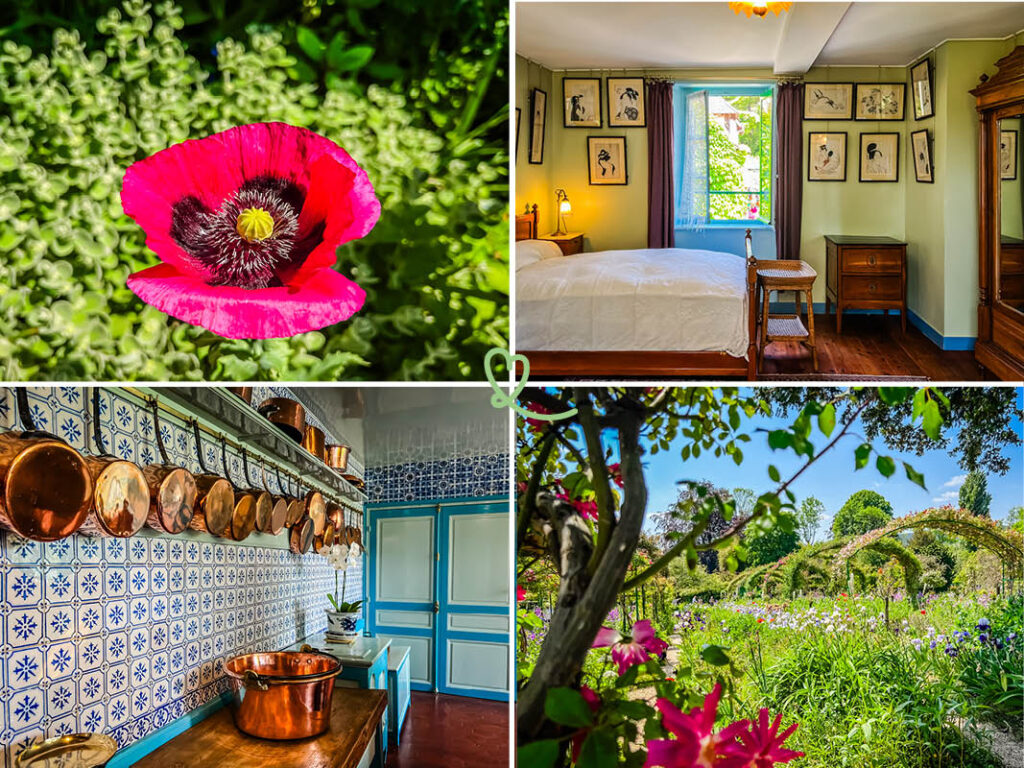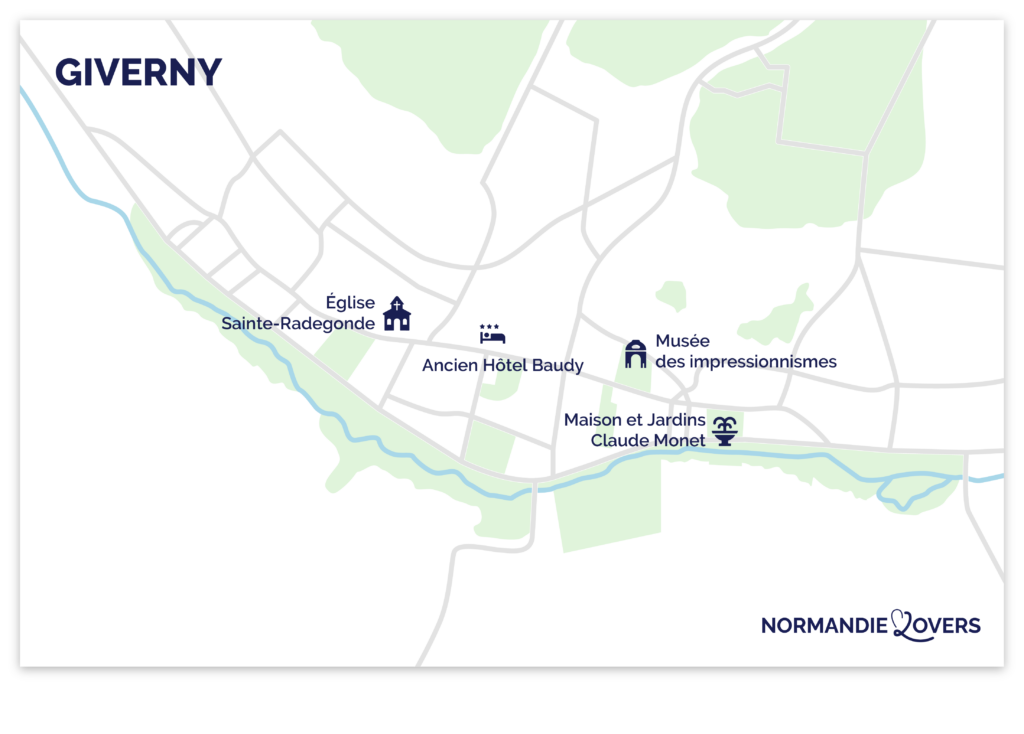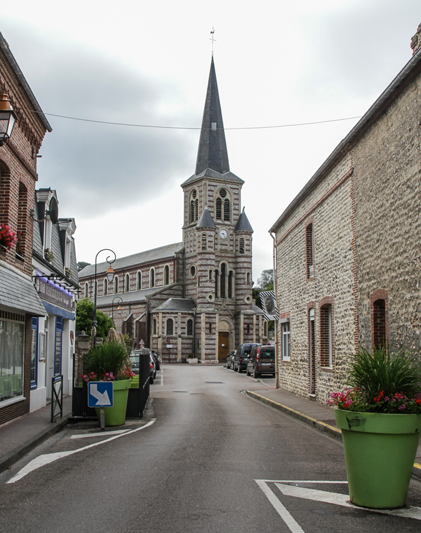A living work of art, Claude Monet’s Normandy home is a must-see in the famous Village des Peintres. Whether you’re passionate about art, botany or simply curious, come and visit the Gardens and House of Claude Monet at Giverny.
You’ll see almost a hundred different plant species, including flowers, trees and plants! These sumptuous gardens inspired the French painter and founder of Impressionism, and still attract crowds today.
In this article, you’ll find pictures of our visit experience, as well as practical tips to help you make up your own mind.

This review is completely independent, we visited anonymously and paid our admission in full.
Why visit Claude Monet’s house and gardens at Giverny?
Are Claude Monet’s house and gardens at Giverny worth it? Our review
Absolutely! Claude Monet’s House and Gardens are among our ideas for things to do in Giverny. This is the place to be:
- the authenticity of Clos Normand: it was in this seemingly untouched pink rendered house that the artist lived with his family for over 40 years,
- Claude Monet’s extraordinary estate: more than just a place to live, the painter turned it into an open-air artistic studio and a source of inspiration,
- diversity of flowers: on one hectare, 64 varieties of flowers share the space with apple orchards, vegetable gardens, trees and other plant species.

Why are the Gardens of Giverny famous?
The Gardens of Giverny and the House of the painter Claude Monet owe their renown first and foremost to their sumptuousness. When he created this magical garden from scratch at the end of the 19th century, his ambition was to have a colorful plant park all year round. Iris, carnation, rose, dahlia, daffodil, water lily, weeping willow, bamboo, Japanese cherry… A host of plant species live together to delight your eyes.
Don’t wait any longer and embark on one of Claude Monet’s wildest dreams by opting for one of the excursions that include the visit!

This timeless place inspired some of the artist’s finest works, such as Les Nymphéas, a series of almost 300 canvases depicting his garden at Giverny. Considered one of the founders of the Impressionist movement, Claude Monet combined his passion for botany with his love of painting.
Our favorite moments
You can read more about our visit in this article, but we wanted to share our favorite moments with you right away:
- Claude Monet’s collection of Japanese prints in his home,
- the main avenue of flowering hoops opposite Clos Normand,
- the traditional Japanese bridge facing the Bassin des Nymphéas in the Jardin d’Eau,
- the kitchen between copper utensils and Rouen earthenware tiles.

VISIT Giverny
Our favorite tours and visits:
- From Paris: Small-group guided tour
- From Paris: Private tour
- From Paris: Tour by bus, then by bike
- On site: Guided tour of the gardens
Our articles:

Practical tips and map: Claude Monet’s House and Gardens, Giverny, France
Where are the Jardins de Claude Monet?
The Gardens and House of Claude Monet are part of the Claude Monet Foundation, 84 Rue Claude Monet, Giverny (27620), Normandy, France. They are located very close to the Musée des Impressionnismes, to the east of the village of Giverny. All points of interest are within walking distance.

- Driving time from Paris: 1h20min.
- Driving time from Caen: 2h.
- Driving time from Rouen: 1 hour.
- Driving time from Évreux: 45min.
- Driving time from Ouistreham: 2h.
These times are approximate and depend on traffic.
OUR ADVICE FOR RENTING A CAR IN Normandy
- Compare prices on our preferred platform: DiscoverCars – one of the best rated sites.
- Choose a car that is comfortable enough (distances can be long) but compact (some parking lots and villages are narrow).
- Think of thecomplete insurance (some roads are tortuous and narrow).
- There is a lot of demand, book it early.

How to get there
To get to Giverny easily and peacefully:
- Organized tours from Paris: this is the easiest option, just sit back and admire the road on an organized tour, and let it wash over you! You can find our favorite excursions to Giverny from Paris here.

- By car: Giverny can be reached from the A13 freeway. The municipality has installed several parking lots to facilitate access to the village. Discover all our tips for renting a car before going to Giverny fromOrly, Roissy-CDG or Beauvais airports.

- By train: the TER Normandie regional train line serves Vernon-Giverny, with regular daily services from Paris, Évreux and Rouen. Vernon SNCF train station is a 30-minute shuttle ride from Giverny. Board one of the 2 shuttle buses that will take you to the village of Giverny, the bus or the Petit train touristique de Vernon (same duration, approx. 30min).
See available timetables and book your train and coach tickets now.
Parking
The municipality of Giverny has installed several parking lots to facilitate access to the village as soon as you arrive. You can then stroll around Giverny on foot. Bicycle parking is also available in the parking lot. There is also a parking lot directly opposite the entrance to the Fondation Claude Monet.

Schedules and prices
Schedules:
- Open year-round from April 1 to November 1, 9:30 a.m. to 6 p.m.
Prices Claude Monet’s House and Gardens:
- Full price: €11.50,
- Children (7 to 17) and students: €7
- PMR rate: €6.
To make your visit even easier, you can opt for an organized tour from Paris, including access to the Gardens and Claude Monet’s House in Giverny. Discover all the options here!
If you’re also visiting the Musée des Impressionnismes in Giverny, a combined ticket for the House and Gardens of Claude Monet is available on site.
Best time to visit the gardens and the house
With almost 630,000 visitors expected in 2022, according to the Claude Monet Foundation, Giverny is a popular destination for tourists. This can be particularly busy during the peak season from June to September. To avoid queues, we recommend weekday mornings or afternoons in spring, late summer and autumn.

VISIT Giverny
Our favorite tours and visits:
- From Paris: Small-group guided tour
- From Paris: Private tour
- From Paris: Tour by bus, then by bike
- On site: Guided tour of the gardens
Our articles:

How long to visit and main difficulties
If you’re visiting the House and Gardens of Claude Monet, we recommend you allow between 2 and 2.5 hours to wander the aisles of this botanical gem in Giverny. There’s sometimes a bit of a wait to get to the House of Claude Monet. If you opt for a visit to the gardens only, allow around 1h30.

The gardens are accessible to people with reduced mobility and baby carriages, although some of the paths are a little narrow. But most are paved and easy to walk on. PRM entrance is via the group checkout.

If you wish to visit the house, please note that there is no PRM access, with steep and sometimes cramped staircases, as it was not designed to accommodate the public.
Plants, flowers and trees may not be touched, and there are no lockers for bags and luggage. Pets are not allowed.

The Gardens of Giverny with children
If you’re visiting the gardens and house with toddlers, you’ll want to use a baby carrier. In the village of Giverny, it’s easy to get around in a stroller.
A range of activities is available for your little ones, including a game booklet and worksheet, a route sheet and a virtual tour… You’ll have plenty to keep them busy! More information on the official website here.

Nearby restaurants
Exploring Giverny and the surrounding area also means taking advantage of its excellent choice of restaurants. Michelin-starred, gourmet, on-the-go, brasseries, tearooms… there’s something for every taste and style! Here’s a small selection of our best places to eat in Giverny:
- Restaurant Salon de thé Les Nymphéas: for the past 15 years, in the heart of Giverny opposite the Claude Monet Foundation, you can enjoy French gastronomic dishes in a pretty, bucolic, flower-filled setting.
- Restaurant Au Coin du Pain’tre: tarts, tasty dishes and fruit cakes await you in the shade of the trees on rue Claude Monet.
- Restaurant Le Jardin des Plumes: a contemporary, intimate setting in the heart of the Village des Peintres, discover the refined, Michelin-starred cuisine of this fine Giverny restaurant.

WHERE TO STAY IN Giverny
Option 1: in the village
Giverny, famous for its gardens and the Village des Peintres, is a magical place… We recommend..:
- Pluie de Roses establishment in a 6000 m2 park with veranda – see prices, photos and availability.
- Hotel La Musardière, charming 3-star establishment in the heart of Giverny – see prices, photos and availability.
- B&B Le Clos Fleuri with cosy rooms, shared lounge and terrace – see details, availability and booking.
- Madame Baudy’s 19th-century house, where painters have stayed – see details, availability and bookings.

Option 2: around Giverny
The medieval town of Vernon is just a 10-minute drive from Giverny. We recommend..:
- Hotel Normandy traditional 19th-century establishment – see prices, photos and availability.
- Maison Anne face to park B&B with garden view – see prices, photos and availability.

Start of the tour: from family home to open-air exhibition space
Nicknamed the Village of Painters, Giverny is famous for having been the home of Claude Monet, the French painter and founder of Impressionism, for 43 years. You can reach the estate on foot from Rue Claude Monet. On the way in, we passed through the store, set up in the famous painter’s 3rd studio. All existing buildings have a purpose!
A family estate in the heart of Giverny
Le Clos Normand is the 1st part of Claude Monet’s home, which we had the pleasure of visiting. As we left the foundation’s boutique, we were greeted by a vast, verdant, flower-filled estate. We were already dazzled!

On the right, you’ll notice a long house with pink rendering and pretty greens. Did you know that this is an old cider press? Bordered by flowerbeds, the artist fell in love with this estate in 1890 and lived here for over 40 years with his blended family. On the outside, take the time to notice the symmetry of the windows and shutters on the 2 floors, as well as the colors in perfect harmony with the surrounding vegetation.

We chose to start our visit with the house, which is what we recommend to avoid queuing afterwards. The influx of visitors later in the day can generate a bit of a wait at the entrance. But you’re more than welcome to start in the gardens before discovering the remnants of the past preserved in this lovely residence. Ready to discover the daily life of this great Impressionist painter?
La Maison du Clos Normand: treasures of yesteryear
Right from the 1st room, we enter the Monet family intimacy. Photographs of the artist and his family, numerous paintings, tapestries, antique furniture such as Napoleon III desks and rattan chairs… The patterns and colors of the salon atelier are sure to catch your eye!

We were overwhelmed by the soul of the place, with all its perfectly preserved period objects. Take the time to observe every detail, because from the bedrooms to the kitchen and dining room, we wanted to look at everything up close with curiosity.

Once you’ve made your way upstairs to the bedrooms, you’ll arrive in the flamboyantly yellow dining room, where you’ll find a host of objects that once belonged to the master of the house. Plate service, antique furniture, vases… Each room deserves your attention, for this house is a veritable art gallery that tells us a great deal about Claude Monet’s life and interests.

When you finish your tour of the house, have you noticed the contrast between the blue and white Rouen earthenware tiles and the copper cookware still intact?
VISIT Giverny
Our favorite tours and visits:
- From Paris: Small-group guided tour
- From Paris: Private tour
- From Paris: Tour by bus, then by bike
- On site: Guided tour of the gardens
Our articles:

An exceptional collection of Japanese prints
As you stroll through his home, you’re sure to notice Claude Monet’s impressive collection of Japanese prints. Are you familiar with these artistic images, printed on paper using a relief or intaglio matrix? Several Impressionists were interested in this Japanese art and drew inspiration from it. Whether genre scenes, landscapes or portraits, Japanese art played a major role in the aftermath of Impressionism and the evolution of Western art in the late 19th and early 20th centuries.

Claude Monet’s estate reveals many references to his fascination with the Rising Sun. Both in his home, with its prints and Meiji era cat on a cushion, and in the gardens, with the traditional Nippon bridge and cherry blossom trees.

Most of the Japanese prints by Utamaro, Hokusai or Hiroshige can be found in the yellow dining room on the first floor, but a few are also scattered around rooms and corridors, so be sure to look up as you descend the stairs.

If this art resonates with you, don’t hesitate to visit the Musée des Impressionnismes in Giverny, just a stone’s throw from Claude Monet’s home. A corpus of prints by Impressionist artists such as Mary Cassatt is on display.
Subscribe to our Newsletter
- Get away from it all with Region Lovers’ beautiful destinations!
- Once a month
- Advertising-free
Outdoor art workshop: 1001 merveilles du Clos Normand at Giverny
Once you’ve left the home of the famous Impressionist artist, head for the Clos Normand garden. You may have caught a glimpse of the spectacular views of flowerbeds and avenues of verdant arches from the 1st floor of the house. We’re off to explore this enchanting garden in bloom all year round, the challenge Claude Monet set himself when he planted all these different species.

With a surface area of one hectare, this estate seemed extraordinary to us. You’ll see an apple orchard, orchard and vegetable garden next to the pink rendered house. 64 varieties of flowers and dozens of trees and plants make up this beautiful botanical ensemble. Among them: iris, carnation, rose, dahlia, daffodil, water lily, weeping willow, bamboo, daisy, Japanese cherry… Can you recognize them?

Created from scratch by the artist on his arrival far from the hustle and bustle of Paris, this garden enabled one of the founders of Impressionism to devote himself to his art while providing a home for his family. He cares for his garden as if it were the apple of his eye, for its flowers are his true source of inspiration for his work. Claude Monet is said to have often repeated, “I don’t need a studio, my studio is the open air”. In fact, he has turned the estate into a veritable open-air space for work and inspiration.

By far our favorite ornamental feature was the flower arches arranged along several of the park’s avenues. They give the gardens a bucolic character, like arches opening a path, and an organized, symmetrical, thoughtful layout. But also untidy and spontaneous, letting the flowers climb all around and fall to the sides.
Do you feel the blend of lightness in the air, the beauty of flowers, the changing light and the softness of water that characterize his art?

A little anecdote: we were curious about this intriguing little pink rendered building and its majestic glass roof to the north-west of the estate. Any ideas? In 1899, Claude Monet decided to create a larger, more functional workspace for himself. He then set up this 2nd house as a 2nd artistic studio, where he installed his canvases and brushes, as well as some of the Japanese prints in his collection.
Today, the site houses the offices of the Claude Monet Foundation, which maintains the gardens and the house in keeping with the wishes of the famous master.
OUR ADVICE FOR RENTING A CAR IN Normandy
- Compare prices on our preferred platform: DiscoverCars – one of the best rated sites.
- Choose a car that is comfortable enough (distances can be long) but compact (some parking lots and villages are narrow).
- Think of thecomplete insurance (some roads are tortuous and narrow).
- There is a lot of demand, book it early.

The famous Bassin aux Nymphéas or Water Garden
Nicknamed the painter-gardener, Claude Monet turned his estate into a monumental work of art. Once you’ve discovered Clos Normand, take the underground footbridge to the other side of the estate. Then stroll by the Bassin aux nymphéas, in the Jardin d’eau, which gave its name to Claude Monet’s monumental work. You’re sure to experience an enchanting journey into the artist’s dreams!

We strolled around the famous Jardin d’Eau or Bassin aux Nymphéas, where many of these wonders float at the bottom of the pond. The strength and beauty of nature were impressive in this place, which stands out from the French style. Climbing plants, hanging and drooping flowers like curtains along the path around the pond, roots and trunks make their way through and create a magnificent tableau.

In addition to Japanese cherry, peony, gingko biloba and maple trees, the pretty traditional Japanese bridge was built by Claude Monet in line with the main driveway of Le Clos Normand. Another reference to his taste for the culture of the Land of the Rising Sun! The artist has also depicted this charming green bridge in some of his paintings. He chooses an oriental atmosphere to welcome his guests on a regular basis.

Come closer and admire the sky surface reflected in the pond where colorful water lilies float. It was this magical spectacle that also transported us, and which Claude Monet masterfully transcribed in his work.
VISIT Giverny
Our favorite tours and visits:
- From Paris: Small-group guided tour
- From Paris: Private tour
- From Paris: Tour by bus, then by bike
- On site: Guided tour of the gardens
Our articles:

Painting and botany: Claude Monet’s passions
Known the world over, Claude Monet’s home undoubtedly reflects his passion for garden design and art. First of all, inside his family home in the Clos Normand, you’ve probably spotted his many paintings in the 1st room of the salon atelier. The canvases give character to the walls of the room, already decorated with the iconic méridienne and Napoleon III desks. Do you see them?

During your visit, you’ll have noticed a few family portraits scattered around the house. Did you know that Claude Monet shared his love of photography with his son Michel? In fact, he had a darkroom built in the building that was formerly the 2nd studio and is now the Foundation’s premises. Numerous photographs document the painter’s work, both in his garden and in his studios. Marc Chagall was even photographed in Giverny when he visited Claude Monet.

We mentioned it earlier, but the painter-gardener’s passion for Japanese culture is unquestionable. A collection of Japanese prints in every room of the house, a reminder of the plant species in the garden and a traditional bridge over the pond… Although he never visited Japan, Claude Monet was particularly sensitive to the art of printmaking.

As you’ll see as you stroll along the paths, the gardens are a real work of art. We imagined Claude Monet working in this verdant park to turn it into the incredible botanical ensemble it is today, in bloom all year round. The marriage of species from all over the world, this assembly of plants each with their own needs and characteristics, is almost a work of goldsmith.

The painter-gardener’s meticulous work is evident in every corner of the garden. It will take you on a journey through all the colors, shapes and textures that abound. From spring through to late autumn, gardens come alive with an explosion of dazzling colors. In fact, a wide variety of flowers can withstand the sun and remain in bloom all summer long, producing beautiful flower beds even in September! Want to discover this Norman jewel? Come on in for a colorful daydream!
OUR ADVICE FOR RENTING A CAR IN Normandy
- Compare prices on our preferred platform: DiscoverCars – one of the best rated sites.
- Choose a car that is comfortable enough (distances can be long) but compact (some parking lots and villages are narrow).
- Think of thecomplete insurance (some roads are tortuous and narrow).
- There is a lot of demand, book it early.

Frequently asked questions
When do the water lilies bloom at Giverny?
In Giverny, the famous water lilies that inspired Claude Monet bloom from May to September. You can admire the Bassin aux Nymphéas in the Jardins du peintre jardinier. Each water lily flower blooms for an average of 4 to 5 days. The flowers open in the morning and close again in the evening, their opening and closing depending on light and heat.
Want to discover the magic of Giverny? Don’t wait any longer and discover all our excursions here!

What’s the best way to get from Paris to Giverny?
In our opinion, the best way to get from Paris to Giverny is to opt for an organized tour, so that you can make the most of your time there and rest during the journey. It’s also convenient to get there by car or rental car. Discover all our tips for renting a car in France fromOrly, Roissy-CDG or Beauvais airports.

How to visit Claude Monet’s gardens?
There are several options for visiting Claude Monet’s gardens, as described above. You can opt for an organized tour from Paris, enjoy your day on site and rest on the way. You can also book a guided tour on your own. Last but not least, find out all our tips for discovering Giverny’s jewels over a full day. Enjoy your visit!





